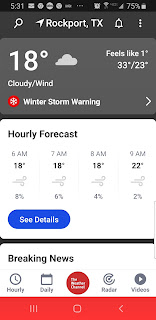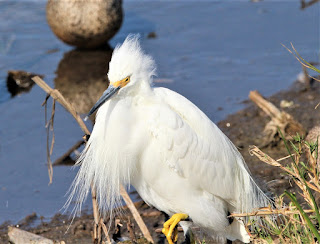It has been fourteen years since we retired, and we have spent part or most of our winters in Rockport/Fulton Texas. Each winter we have driven past the Heron Rookery alongside Little Bay and while taking a few pictures, have never really stopped to study the rookery.
This year, Renita suggested we should spend some time at the rookery. It turned out to be a great idea and we will no longer look at great blue herons as too common and plentiful to bother about. Grabbing our cameras, binoculars, and tripod we drove to the Live Oak Tree Rookery. Parking the car, we immediately noticed that several of the herons were stretching their necks straight up, much as whooping cranes do.
The bird’s color brightens, and the lore turns green/blue along with a change of color of the bills and upper legs. In the accompanying photo you can see the pink and yellow of the bill along with the green/ blue lore. The long crest length and a breeding color grows along with other breading plumage.
Great blue herons are usually solitary animals but during breeding season the males take up and defend a nest position usually with other great blue herons. This probably allows for common defense against predators. After the larger males claim their spot, they then begin to attract the females. At first, they defend their spot against them but soon change their behavior and pair up with the smaller females.
The courtship ritual is pretty complex and includes a greeting in which both stretch their necks straight up, emitting a call to each other. They also exhibit circular flights and crest raising.
After they have landed, they then engage in bill duels and bill snapping with one actually taking the other’s bill in its own.
The large birds, a full-grown male has a wingspan of six feet and stands about four feet tall, construct a large nest which grows in size each year, although the birds select a new mate each year.
Both of them also engage in neck caresses and preening. As the female sits on the nest the male lands and searches for twigs, (the male also sits on the eggs),
some quite large and carries them to her. After he shakes the twig, she inspects it and taking it, she shakes it before setting it in the nest.
Upon mating the male leaps on top of the back of the female and they perform what is called the cloacal kiss.
The male transfers sperm by rubbing its cloaca with hers after which the female stores the sperm and fertilizes each egg over a period of laying, (several days).
After incubating for twenty-eight to thirty days they hatch and after several months leave the nest for a solitary life.
The juveniles reach maturity after three years and may then join the breeding colony. We were so pleased to be able to take images of the behavior and we will no longer look at this beautiful bird without thinking of what we have learned! Clear skies




















































